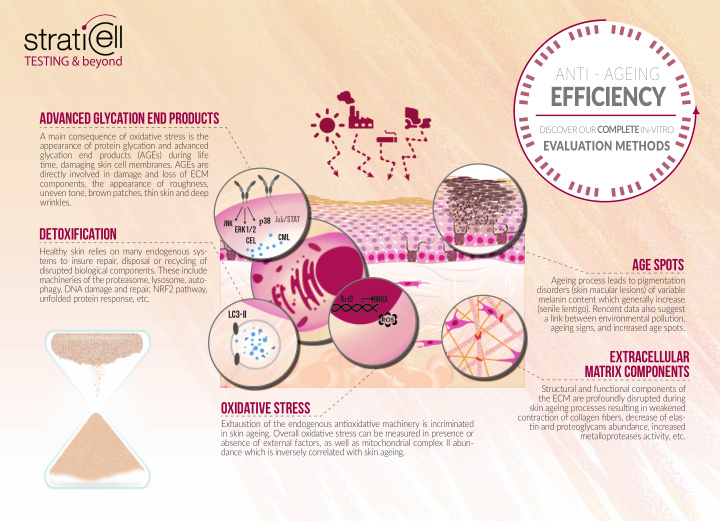



ANTI - AGEING EFFICIENCY Advanced glycation end products DISCOVER OUR COMPLETE IN-VITRO A main consequence of oxidatjve stress is the EVALUATION METHODS appearance of protein glycatjon and advanced glycatjon end products (AGEs) during life tjme, damaging skin cell membranes. AGEs are directly involved in damage and loss of ECM components, the appearance of roughness, uneven tone, brown patches, thin skin and deep wrinkles. J ak /STAT p 38 JNK ERK1/2 Detoxification CML CEL Healthy skin relies on many endogenous sys - tems to insure repair, disposal or recycling of Age spots disrupted biological components. These include machineries of the proteasome, lysosome, auto - Ageing process leads to pigmentatjon phagy, DNA damage and repair, NRF2 pathway, disorders (skin macular lesions) of variable unfolded protein response, etc. melanin content which generally increase N rf 2 HMOX (senile lentjgo). Rencent data also suggest LC3-II a link between environmental pollutjon, ageing signs, and increased age spots. Extracellular matrix components Structural and functjonal components of the ECM are profoundly disrupted during Oxidative stress skin ageing processes resultjng in weakened contractjon of collagen fjbers, decrease of elas - Exhaustjon of the endogenous antjoxidatjve machinery is incriminated tjn and proteoglycans abundance, increased in skin ageing. Overall oxidatjve stress can be measured in presence or metalloproteases actjvity, etc. absence of external factors, as well as mitochondrial complex II abun - dance which is inversely correlated with skin ageing.
CHALLENGING SKIN PIGMENTATION DISCOVER OUR ExCLusivE in vitro DEVICE DERMOSCOPY melanosome transfer Melanosomes are transferred to sur - rounding keratjnocytes in which they localize to the perinuclear area. melanosome maturation During their maturatjon, melanosomes move towards the extremity of dendrites through a microtubule-dependant intracellular transport. melanogenic pathways The complex & dynamic process of melanogenesis involves an extensive intercellular cross-talk that actjvates signalling responses such as MC1-R transcriptional regulation pathway actjvatjon. MITF is a major transcriptjon factor that regulates melanocyte functjon from their development to their response to environmental stjmuli con - trolling melanosome formatjon and expression of melanogenic enzymes. enzymatic conversion Tyrosinase and tyrosinase-related proteins (TRP-1/2) are the critjcal me - lanogenic enzymes responsible for me - lanin synthesis.
Sensitive INFLAMMATION ATOPIC DERMATITIS Skin PSORIASIS UbD UV s NF- к B TRANSLOCATION PMA BARRIER DISRUPTION -28%-40% Increased nuclear translocatjon of Defects in the NF-кB is an important pathogenic protectjve physical barrier lead to a decrease factor involved in many acute & chronic in expression of difgerentjatjon markers such infmammatory disorders. as fjlaggrin (FLG), involucrin (IVL), loricrin (LOR) & trans-epithelial electrical resistance (TEER) while facilitatjng allergens/pathogens invasion. TEER +18% LOR IVL U B D U B D inflammation inflammation C TRL 20µM 60µM chronic TNFα acute FLG NF -кB +29% IL8 IL6 PGE2 IL1 LTB4 x19 RHE RHE-PSO x10 -64% -61% MORPHOLOGICAL CHANGES CYTOKINES & CHEMOKINES RELEASE Infmammatory dermatoses are characterized Productjon of primary proinfmammatory cytokines by the presence of abnormal keratjnocyte prostaglandin E2 (PGE2), leukotriene B4 (LTB4), in - proliferatjon (acanthosis) or accumulatjon of terleukin-1 (IL-1), interleukin-6 (IL-6), interleukin-8 intraepidermal edema (spongiosis) observed A A (IL-8), & tumour necrosis factor-ɑ (TNF-ɑ). C TRL . C TRL . M R EF M R EF P P in psoriasis & AD, respectjvely. PREVENTIVE CURATIVE
Discover our TRANSCRIPTOMICS TOOLS for TARGET IDENTIFICATION DIFFERENTIATION & EPIDERMAL BARRIER & mechanism of action LIPID SYTNHESIS & TRANSPORT ANTIMICROBIAL DEFENSE CELL JUNCTIONS Epidermal Benefits h h h h Oh AGE SPOTS INFLAMMATION & CHEMOTAXIS DEPIGMENTATION LIPID HOMEOSTASIS MELANOGENESIS BARRER RECOVERY AGE SPOTS PRURITUS Pigmentation Skin BARRIER & Tissue Cohesion RECYCLING & DETOXIFICATION DNA DAMAGE REPAIR EXTRA CELLULAR MATRIX MODELING DRUG METABOLISM OXYDATIVE STRESS RESPONSE Pollution & DEtoxification AUTOPHAGY & RECYCLING CELLULAR SENESCENCE dermal Benefits N rf 2 HMOX cyp450
POLLUTION AND ENVIRONMENTAL STRESSES drug metabolism The cytoplasmic xeno-sensor AhR leads to inductjon of xenobiotic-responsive elements such as CYP proteins family. inflammatory response Pollutants stjmulate the re - lease of pro-infmammatory mediators such as PGE2 & unfolded protein IL cytokines. response Autophagy has a pivotal role in recycling damaged oxidative stress non-functjonal response organelles & unfolded The depletjon in enzy - proteins. matjc and nonenzymatjc antjoxidant capacity leads to a chronic and vicious oxidatjve state. keratjnocyte Matrix modelling or fjbroblast DNA damage & repair Among others, Matrix MetalloProteinases contribute to matrix modulatjon that af - fects cell-cell/matrix interactjons critjcal for If not controlled, DNA alteratjons skin integrity. could afgect cell cycle and induce apoptosis.
Recommend
More recommend